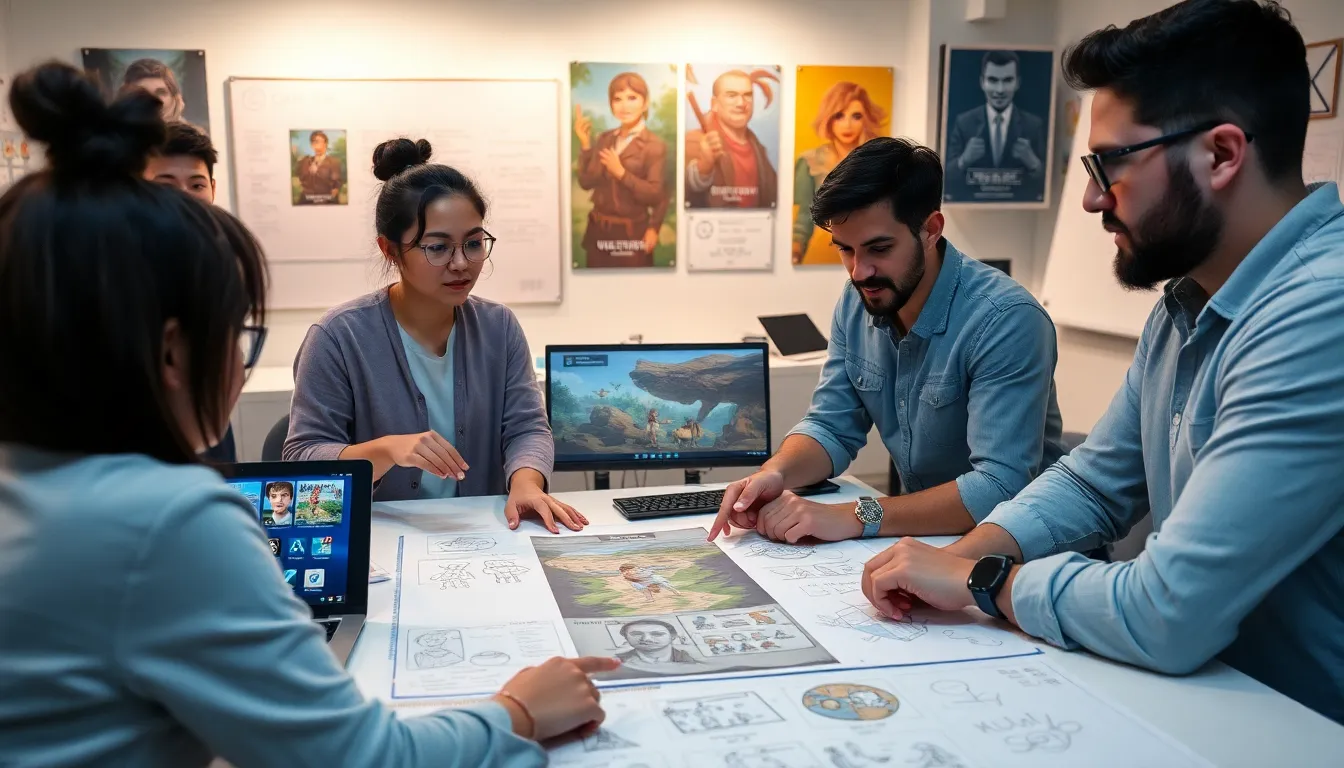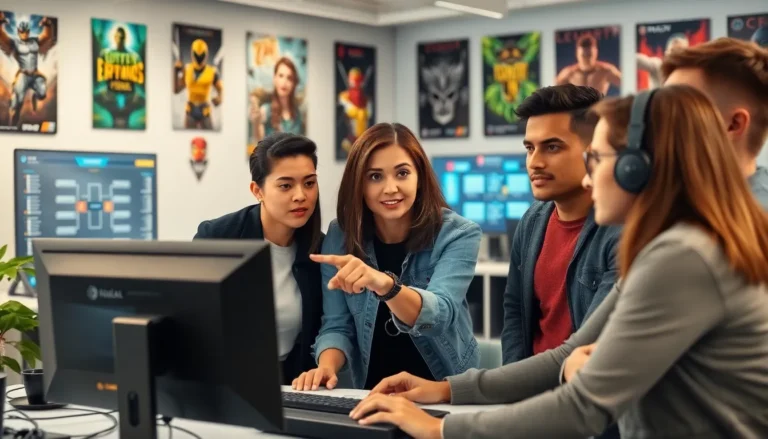Game development isn’t just about coding and graphics; it’s a thrilling adventure that transforms ideas into interactive experiences. Picture a group of creative minds, fueled by caffeine and passion, embarking on a quest to build the next blockbuster game. Each stage of development is like leveling up in a video game, complete with its own challenges and rewards.
From the initial concept to the final polish, every phase is crucial. It’s where brainstorming meets technical wizardry, and where art and storytelling collide. Whether it’s designing characters that players adore or crafting worlds that spark imagination, every step counts. So buckle up and get ready to explore the fascinating stages of game development, where every pixel tells a story and every line of code brings dreams to life.
Table of Contents
ToggleOverview of Game Development
Game development encompasses several stages, with each phase playing a crucial role. Concept development serves as the foundation, where ideas transform into detailed game designs. Designers outline storylines, characters, and gameplay mechanics, ensuring a comprehensive vision.
Once the concept solidifies, pre-production begins. During this stage, teams define project scope, budget, and timelines. Prototypes emerge as essential tools, allowing developers to test ideas and mechanisms early. This phase attracts artists, designers, and programmers, promoting collaboration.
Production follows, marking the most intensive phase. Developers create graphics, sound, and game systems, bringing the vision to life. Artists and animators focus on character modeling and environment creation. Programmers write the code, implementing gameplay features and ensuring everything functions smoothly.
Testing occurs concurrently with production. Quality assurance specialists identify bugs and potential issues, striving for a polished final product. Feedback loops facilitate refinements, allowing developers to make necessary adjustments.
Post-production wraps up the development cycle. Final touches polish graphics and sounds, enhancing overall quality. Marketing efforts begin, aiming to create awareness around the launch. Even after release, ongoing support, including patches and updates, ensures the game remains engaging.
Each stage of game development requires specialized skills and collaboration. While creativity fuels the initial concept, technical expertise brings the game to fruition. Developers harmonize distinct processes, crafting experiences that resonate with players.
Pre-Production

Pre-production sets the foundation for a game project. It involves detailed planning to ensure successful execution in later stages.
Concept Development
Concept development captures the essence of the game. This phase involves brainstorming ideas, defining storylines, and creating character arcs. Designers outline gameplay mechanics that shape player interactions. Documentation serves as a blueprint, detailing the vision behind each game element. Established concepts guide the team throughout the project. Collaborating during this stage fosters creativity and aligns the goals of various departments. The outcome of this phase significantly influences the overall experience.
Prototyping
Prototyping allows teams to bring concepts to life in a tangible way. This process creates early game versions, testing core mechanics and gameplay feasibility. Developers build simple models or digital mock-ups to visualize ideas. Feedback gathered during playtesting helps refine features and identify potential issues. Iterative testing promotes continuous improvement, allowing the team to make informed decisions early on. Effective prototypes can sway stakeholders and secure funding for the full production phase, ensuring everyone shares the same vision.
Production
Production represents the most intensive phase of game development, serving as the heartbeat of the project. During this stage, teams focus on both design and development aspects.
Design and Development
Design and development require dedicated collaboration among various team members. Programmers create game systems, integrating mechanics and features based on the blueprints from earlier stages. Designers refine gameplay elements, emphasizing player experience and interaction. Game engines often facilitate this process, allowing for real-time iterations and testing. Regular playtests help identify gameplay issues, ensuring that the vision remains consistent and practical.
Art and Sound Creation
Art and sound creation enhance the game’s immersive experience. Artists develop visual assets, including character models, environments, and animations, aligning with the game’s aesthetic. Regular reviews ensure adherence to the artistic vision. Sound designers craft audio elements, such as music, sound effects, and voiceovers, which contribute to atmosphere and engagement. Synchronization between visual and audio elements is key, as both aspects work together to create a cohesive experience for players.
Testing
Testing plays a critical role in game development, ensuring a polished and engaging final product. The focus remains on identifying and addressing potential issues before launch.
Quality Assurance
Quality assurance (QA) involves systematic testing of the game to ensure it meets quality standards. Testers evaluate various elements, including gameplay mechanics, graphics, and performance across devices. They meticulously document bugs and inconsistencies to facilitate necessary fixes. Rigorous testing protocols, such as regression testing, guarantee that new changes don’t introduce new problems. Both functionality and user experience benefit from these testing efforts, ultimately contributing to a more refined game.
User Testing
User testing gathers feedback from a diverse group of players to understand their experiences. Observing players as they interact with the game offers valuable insights into usability and engagement. Specific tasks help identify areas that may confuse or frustrate users. Feedback collected drives adjustments in gameplay, interface, and pacing, enhancing the overall player experience. Informal settings or organized sessions can be utilized to facilitate this process, ensuring that the game aligns with audience expectations.
Post-Production
Post-production plays a vital role in finalizing a game and ensuring its success in the market. The focus during this phase centers on launching the game and providing ongoing support.
Launch
Launch marks the culmination of extensive development efforts. It involves releasing the game to the public through various platforms, including consoles, PCs, and mobile devices. Marketing campaigns, targeted at reaching potential players, play a crucial role in generating interest and excitement. Successful launches can depend on pre-release activities such as trailers, demos, and influencer outreach. Clear communication about the game’s features and unique selling points also contributes to an effective launch strategy. Coordinated release times across regions can enhance visibility. Engaging with the community during this period helps maintain momentum and builds a loyal player base.
Post-Launch Support
Post-launch support ensures a game’s longevity and continued engagement. Developers address player feedback by releasing patches and updates that fix bugs, improve gameplay, and introduce new content. Community engagement through forums and social media can provide direct insights into player experiences. Regular updates can enhance user experience and foster a dedicated player community. Events, such as seasonal events or special challenges, can keep players returning for more. Continuous support not only maintains game quality but also cultivates a positive relationship with the player base, ensuring the game thrives in a competitive market.
The stages of game development represent a dynamic interplay of creativity and technical skill. Each phase contributes uniquely to the final product, ensuring that games not only meet quality standards but also resonate with players. From initial concepts to post-launch support, every step is crucial in crafting engaging experiences that captivate audiences.
As developers navigate this intricate process, collaboration and feedback become essential tools for success. By embracing these stages, game developers can create immersive worlds that players will love to explore. The journey may be challenging, but the rewards of delivering a captivating game make it all worthwhile.





